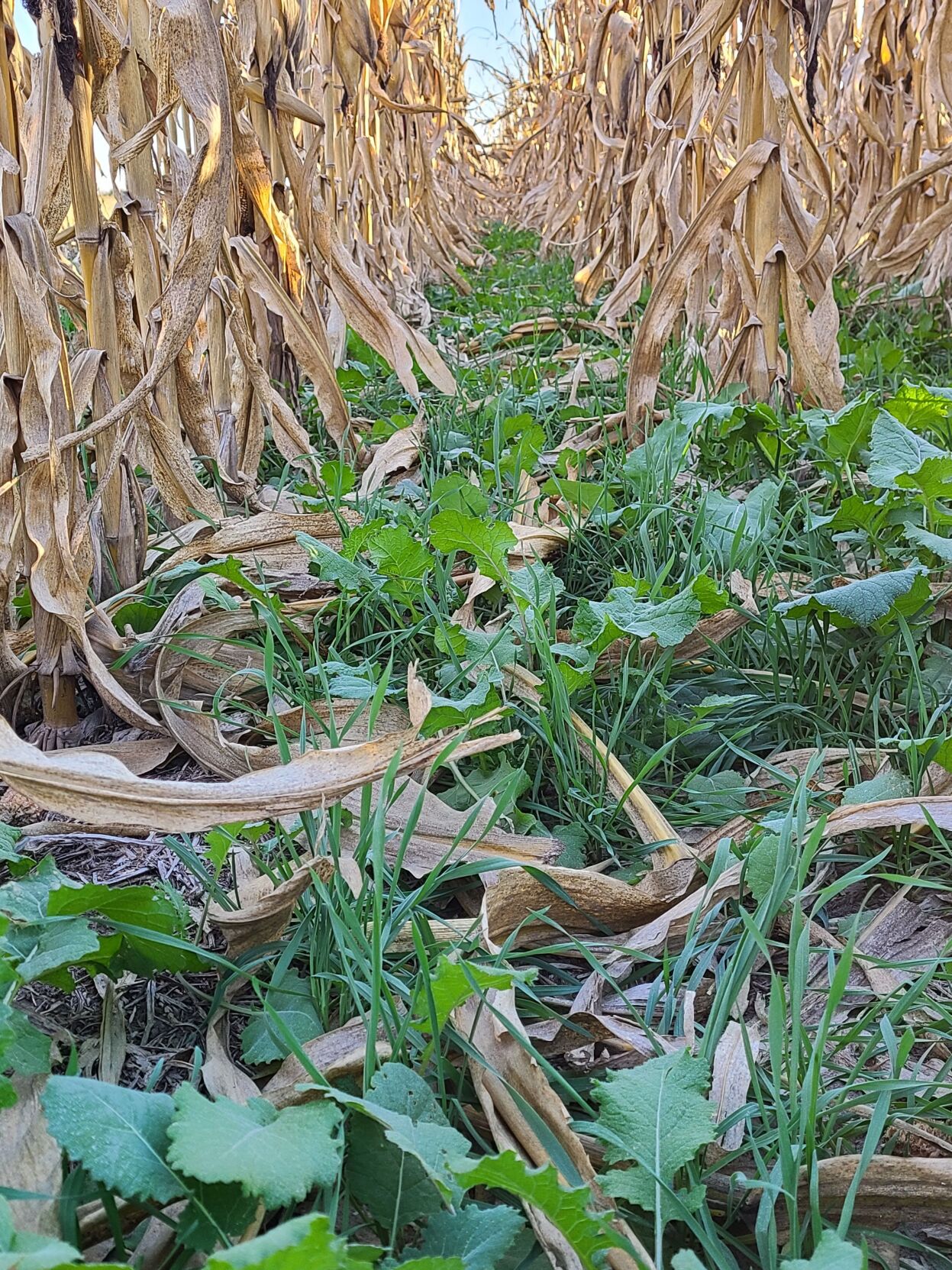Farmer-led initiatives are a proven formula for building conservation practices. A cover crop initiative follows that blueprint.
The Kansas Climate Smart Initiative had set a goal of 100,000 acres in 2022, according to Troy Munsch, an agreement consultant for the Kansas Association of Conservation Districts. The program worked with multiple entities and enrolled 100,000 acres in half of the state’s counties and he hopes to double that number and include all 105 counties. Partners include ADM, the U.S. Department of Agriculture’s Natural Resources Conservation Service and National Fish and Wildlife Foundation.
KACD received assistance from the National Fish and Wildlife Foundation to help producers. Awarded under the NFWF’s Midwest Cover Crop Initiative, the grant supports implementation of beneficial agricultural practices. Other partners participating include the Kansas Department of Agriculture’s Division of Conservation and the Soil Health Alliance.
KACD’s role has been to promote the program and provide technical assistance if requested. Local conservation districts take the signups and submit applications to ADM, which then pays farmers.
“What we liked when we started working with ADM was the program helps to tell the story of all the good farmers and ranchers have been doing all along,” said Munsch, who lives in Salina and has an extensive background in agronomy and crop production. “They just don’t want to brag it up.”
Those many untold stories from unsung heroes included reducing greenhouse gas emissions, providing water infiltration and building soil health he said. Cover crops also can help provide habitat for wildlife.
Participants in the Kansas program received $10 an acre for their stewardship.
A cover crop had to be planted in 2022 and meet Natural Resources Conservation Service requirements, Munsch said. The cover crop cannot be hayed or removed mechanically; however, it could be set up to graze, which can help livestock producers.
Contracts could be for one year or multiple years, he said. Providing flexibility helped producers who may have factors beyond their control in the same year. The KACD—besides promotion—can also be called upon to provide technical expertise. He uses his connections with the NRCS to find answers to producers’ complex questions.
“Implementing conservation on the landscape has always been about building partnerships,” said Andrew Lyon, director of the Kansas Department of Agriculture’s Division of Conservation. “Many private companies have established sustainability goals and need state and local partners to help implement programs such as the Midwest Cover Crop Initiative. The success of the ADM program paves the way for other companies to get involved which ultimately benefits farmers and ranchers across Kansas.”
A new tool
Cover crops can have different meanings to producers, he said. Growers understand cover crops can be positive for soil health. At one time cover crops were thought to be a single-species mix and growers would use it for weed control or lowering surface temperature.
As farmers learned more,they found they could take out a shovel and as they dug deeper if they found hardpan they could deploy deep-rooted cover crops to break it up, Munsch said. Cover crops can also help reduce fertilizer costs.
Having a familiar local partner is reassuring to them, he said. The simplicity and flexibility within the program is appealing to Munsch. The Kansas Climate Smart Initiative is “very straight forward about planting cover crops.”
The commitment is echoed by ADM. Munsch said when the program started western Kansas farmers in particular were in a drought that lingers today. ADM said if producers could not plant a cover crop there would be no financial ramifications, he said.
In eastern Kansas, particularly in the northeast region, the drought’s impact was minimal and that raised hopes for a successful start and conservation districts promoted the program to producers.
Marshall County has 20,057 acres under contract to lead the state. The next four are also in that region, Nemaha, 8,684 acres; Jackson, 8,237 acres; and Doniphan, 7,463 acres.
The goal is to get to 200,000 acres in 2023 and also to expand it to central and western Kansas. Even in 2022, there were several counties from those regions with significant enrolled acres. They included Pawnee, 6,241 acres; Ellis, 4,821 acres; and Meade, 4,520 acres.
Sign up for HPJ Insights
Our weekly newsletter delivers the latest news straight to your inbox including breaking news, our exclusive columns and much more.
As the initiatives grows in popularity, Munsch said, the overall simplicity has been a selling point. Arrangements offer flexibility for the landowner and tenant.
Farmers wanted a streamlined application process. The forms for the Kansas program are two pages and farmers can sign up via application in about 15 minutes that a district conservation manager then submits to ADM. An ADM contractor reviews the application and may have some follow up questions for the producer.
ADM officials enjoy working with producers and that commitment is genuine, Munsch said. About 90% of the producers received checks for their 2022 participation by late April.
Raising awareness
Working in partnership with producers helps to raise awareness, according to another supporter of the program. Jennifer Simmelink of Jewell County, coordinator for the Kansas Soil Health Alliance, works with and supports district managers in each conservation district. One suggestion that took hold was to have farmer-to-farmer discussions at the grassroots level. The goal is to enhance peer-to-peer soil health learning.
“When we talk soil health or with someone who may not know as much about cover crops, we know there are different ways to approach it.”
As much as having success with seeded acres is a benchmark so is building relationships and support systems, she said.
Simmelink said in addition to the farmer-to-farmer discussions, conservation districts can have a formal event that might include field tour days. The soil alliance can help by providing topic and speaker suggestions. She has set up a private Facebook group as another way for district managers to have peer-to-peer discussions and in that group flyers can be shared about events and up-to-date information. She also works with district managers who may not use social media. Those farmers can reach out to their local conservation district to be included on flyers and learn other information.
The private Facebook group is for the conservation district managers so they can see what other counties are doing for their farmer-to-farmer discussions, she said. District managers who are not on Facebook are emailed a summary each month.
In the 95 Kansas counties where USDA services centers are located conservation districts are co-located with NRCS, which helps with convenience.
Dan Meyerhoff, the KACD executive director, praised the program.
“This program provides sustainability and emphasizes the benefits of regenerative agricultural practices. The ultimate goal is to create more value for the crops farmers are growing,” he said. “This is a total team effort, but the majority of the credit goes to our local conservation districts. They are the driving force behind making sure local producers are made aware of those opportunities.”
It is working well
Simmelink said the team effort has taken hold and lends itself to optimism.
“We’re barely three months in and ‘we’re starting to roll.’ There will continue to be strong interest,” Simmelink said. “We’re trying to keep it simple. We know our conservation district managers wear a lot of hats.”
She also said the board of supervisors, who are farmers and ranchers, are encouraged to participate in farmer-to-farmer discussions because they can help share information with neighbors.
“We really appreciate all the partners on the project,” she said, adding that farmer-led initiative is the right approach.
Dave Bergmeier can be reached at 620-227-1822 or [email protected].




